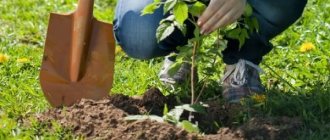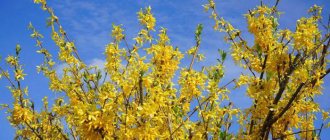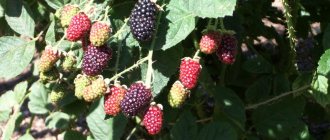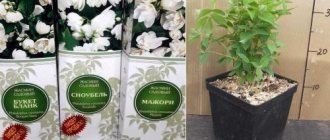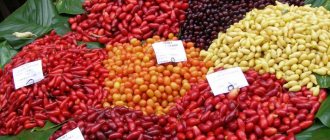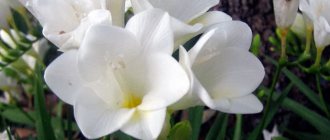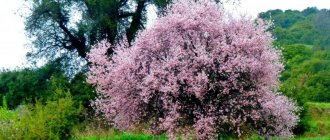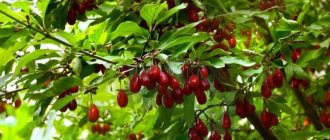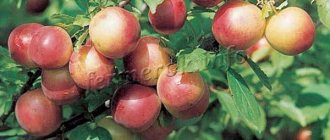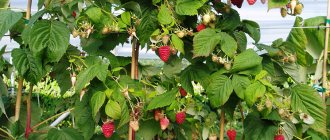Nectarine
Nectarine is truly an amazing fruit. Nature's mistake. It was first mentioned as a fun fact in an English book in 1616. A couple of centuries later, scientists began to study the phenomenon and came to the conclusion that it all began when peach trees began to self-pollinate. From time to time, minor glitches occurred - the buds did not develop as expected, and the fruits turned out not fleecy and silky, but smooth. This process was called classical mutation.
Mutant nectarines appeared when they wanted and where they wanted - in one season they could ripen on one peach tree, in another - on another. Nature itself corrected its mistakes, so people who appreciated a random fruit had to get down to business with their own hands and learn how to graft it (as gardeners say, “into the bud”). And the mutation became a variation.
The fruits of early varieties of nectarine ripen earlier than all other stone fruits, which makes this fruit popular among amateur gardeners.
Nectarine is more resistant to diseases and pests than peach. In addition, new winter-hardy varieties have recently been developed that can be easily grown in the North Caucasus and the Volgograd region.
In recent decades, nectarines have gained even greater popularity when large-fruited (up to 200 g) varieties with yellow flesh appeared, which attract people with their elegant appearance, dense, tear-resistant skin of the fruit, and their high taste and technological qualities.
Harmful properties
You are allowed to eat no more than 4 nectarines per day.
If you abuse the fruit, side effects may occur:
- bloating;
- intestinal disorder;
- increase in blood glucose.
Remember, the pit of a pubescent peach contains poisonous hydrocyanic acid, so only the amniotic pulp is eaten.
100 g of fruit contains 88 g of water. To avoid frequent urination at night and sleep problems, it is recommended to exclude nectarine from the evening diet.
Contraindications:
- diabetes;
- allergy;
- children up to 7 months;
- stomach ulcer in the acute phase.
Use the fruit with caution when breastfeeding so as not to cause an allergic reaction in the baby.
Nectarine and peach
The nectarine is a fruit resulting from a natural genetic mutation of the peach through the process of self-pollinating trees, and not a peach crossed with a plum (as many believe). The difference is just one gene, due to which the skin of a nectarine is smooth like a plum, and the flesh is denser than that of a peach.
Latin name: Prunus persica var. nucipersica.
English name: Nectarine.
Family: Pink - Rosaceae.
Parts used: fruits, leaves.
Photo, description, composition and calorie content of nectarine.
Botanical description. These nectarine and peach trees are virtually indestructible.
Habitat. The nectarine was supposedly domesticated in China over 4,000 years ago. If the peach is a heat-loving plant, then nectarine has frost-resistant varieties.
Benefits of nectarine
The beneficial properties of nectarines are due to the presence in their composition of a complex of vitamins and biologically active substances similar in composition and quantity to peach. In addition, nectarine is a valuable source of pectin, fiber and fructose. Eating nectarine has a preventive effect against cancer, atherosclerosis and hypertension. Nectarine also promotes the digestion of fatty and heavy foods, enhancing the secretion of the digestive glands.
The high content of vitamins A and C in nectarine fruits has a beneficial effect on the skin, retaining moisture in its cells. The high potassium content in nectarine helps normalize the functioning of the nervous system, and pectin compounds inhibit the activity of harmful microorganisms. The insoluble fiber contained in nectarines is necessary for the normal functioning of the intestines, while preventing the development of certain diseases of the digestive tract. Soluble fiber, in turn, has a positive effect on the cardiovascular system, as it helps reduce blood cholesterol levels.
Which is healthier, a nectarine or a peach, you can decide for yourself using the table below for the content of substances beneficial to the body in both fruits.
Nutritional value table for 100 grams of nectarine and peach
100 grams of fresh nectarine and peach fruits contain:
| Fruit composition | Nectarine | Peach |
| Water | 87.59 g | 88.87 g |
| Calorie content | 44 kcal | 39 kcal |
| Proteins (proteins) | 1.06 g | 0.91 g |
| Fats | 0.32 g | 0.25 g |
| Carbohydrates | 10.55 g | 9.54 g |
| Sugar | 7.89 g | 8.39 g |
| Sucrose | 4.87 g | 4.76 g |
| Glucose (dextrose) | 1.57 g | 1.95 g |
| Fructose | 1.37 g | 1.53 g |
| Maltose | 0.00 g | 0.08 g |
| Dietary fiber | 1.7 g | 1.5 g |
| Ash | 0.48 g | 0.43 g |
| Vitamins | Nectarine | Peach |
| Vitamin A | 332 UI | 326 UI |
| Vitamin B1 (thiamine) | 0.034 mg | 0.024 mg |
| Vitamin B2 (riboflavin) | 0.027 mg | 0.031 mg |
| Vitamin B3 (niacin) | 1.125 mg | 0.806 mg |
| Vitamin B4 (choline) | 6.2 mg | 6.1 mg |
| Vitamin B5 (pantothenic acid) | 0.185 mg | 0.153 mg |
| Vitamin B6 (pyridoxine) | 0.025 mg | 0.025 mg |
| Vitamin B9 (folate) | 5 mcg | 4 mcg |
| Vitamin B12 (cyanocobalamin) | 0.00 mcg | 0.00 mcg |
| Vitamin C (ascorbic acid) | 5.4 mg | 6.6 mg |
| Vitamin E (alpha tocopherol) | 0.77 mg | 0.73 mg |
| Vitamin K | 2.2 mcg | 2.6 mcg |
| Betaine | 0.2 mg | 0.3 mg |
| Beta carotene | 150 mcg | 162 mcg |
| Minerals | Nectarine | Peach |
| Iron | 0.28 mg | 0.25 mg |
| Potassium | 201 mg | 190 mg |
| Calcium | 6 mg | 6 mg |
| Magnesium | 9 mg | 9 mg |
| Manganese | 0.054 mg | 0.061 mg |
| Copper | 0.086 mg | 0.068 mg |
| Sodium | 0 mg | 0 mg |
| Selenium | 0.0 µg | 0.1 mcg |
| Phosphorus | 26 mg | 20 mg |
| Fluorine | 0 mcg | 4.0µg |
| Zinc | 0.17 mg | 0.17 mg |
Nutrient content data is taken from the US Department of Agriculture database.
What is healthier: nectarine or peach?
The benefit to the human body of a fruit, vegetable or any food product is determined by its composition (nutritional value). In terms of the content of vitamins and minerals, nectarine and peach are similar, but there are also differences. The table shows that nectarine lacks microelements such as selenium and fluorine. Selenium is necessary to improve immunity, and fluoride, together with phosphorus and calcium, ensures strong bones and teeth.
In Finland, for example, after introducing selenium into the diet, the overall incidence rate fell by 47%! At the same time, the number of cancer diseases decreased by 1.8 times, endocrine diseases by 77%, and heart and vascular diseases by 2.5 times.
Nectarine contains more vitamin E, vitamins B1, B3, B4, B5, B9, iron, potassium, copper, fiber, but less vitamin C. Peach has lower calorie content, higher sugar and glucose content. A peach is juicier and sweeter than a nectarine, but decide for yourself which fruit, based on its composition, is healthier from your point of view.
Contraindications for the use of nectarine are the same as for peach.
Useful properties and contraindications of the fruit
Nectarine pulp is endowed with many beneficial properties. It is used to maintain health and get rid of various functional problems. Only excessive consumption of unpeeled fruit kernels can cause harm. The seed peel contains a toxic element - hydrocyanic acid, which, when accumulated, leads to various disorders and poisoning.
Beneficial properties for a woman’s body
An indicator of health for the fair half of humanity is a well-groomed and blooming appearance. Women are recommended to eat nectarines for beauty and well-being. They help keep the body in good physical shape:
- improve well-being, increase mood and activity;
- normalize hormone levels;
- prevent vitamin deficiency rashes;
- I improve the appearance and condition of hair, nails and teeth;
- help overcome the effects of stress and fatigue;
- stimulate the gastrointestinal tract and cleanse the intestines of toxins.
Women can not only eat enough fresh fruits, but also use them externally as masks. This approach will help preserve youth for many years.
Benefits and harms to men's health
The fruits of the plant provide invaluable assistance to the male body. Especially useful for athletes to maintain good physical shape, endurance, and build muscle mass.
The strong half of humanity uses nectarines for:
- preventing the risk of developing chronic diseases;
- strengthening the immune system;
- improving joint function;
- stabilization of kidney function, prevention of stones;
- restoration and improvement of brain function, especially memory;
- maintaining normal levels of male hormones;
- improving prostate function.
The harm to the product can be traced to excessive use. Fruits are able to quickly and in large quantities remove fluid from the body through urination. If a man fails to get to the toilet on time and has to endure it for a long time, the possibility of urolithiasis increases. There are contraindications due to the increased content of bile in the gastrointestinal tract.
Nectarine for pregnant women: benefits and contraindications
The richness of vitamins and minerals in the fruit has a beneficial effect on the well-being of the mother expecting her baby. Nectarines are especially good in the first trimester of pregnancy. They help prevent many diseases and disorders:
- give elasticity to the skin and support its natural barrier;
- support the normal functioning of the cardiovascular system and promote blood production;
- improve immunity;
- prevent neural tube malformations that can harm the development of the child’s central nervous system;
- improve vision, reduce the risk of diseases of the visual organs;
- prevent the occurrence of cancer and other malignant tumors;
- relieve muscle spasms.
Contraindications to the use and use of this product are especially acute if a pregnant woman has an allergic reaction. Eliminate or minimize its amount in case of diabetes mellitus to avoid an increase in blood sugar levels. The use of fruit kernels or its pulp with a cracked stone is excluded due to the risk of hydrocyanic acid poisoning.
Sharafuga: reproduction
Since Sharafuga is a hybrid, it does not reproduce by seeds. You can propagate the hybrid yourself using cuttings. Prepare planting material in the fall or spring before planting. Cut cuttings 15-20 cm long, remove excess leaves, leaving only 2-3 buds. In winter, they can be stored in a damp cloth in the refrigerator or planted to germinate until spring. Soak the cuttings in Kornevin solution for a day, then plant in fertile and well-moistened soil. Plant the cutting at an angle. Carry out regular watering and fertilizing.
In the spring, when the weather improves and frosts pass, you can plant the grown seedlings in open ground.
Growing nectarines
The first thing you should know before growing nectarines is the types of soil that work best for this plant. It is best that the soil in the area where nectarine will be grown is sandy or loamy. Choosing a site with heavy clay soil is unacceptable, since in such conditions the seedling simply will not take root. Also, you should not plant nectarine in a place characterized by a high groundwater level, as this will have a detrimental effect on its root system.
Peach nectarine is a light-loving plant. Shade from buildings or other larger trees should obscure it for no more than two hours during the day.
Advice! Peach trees and crosses between them should not be grown nearby. This can provoke the development of quite serious diseases, predominantly of a fungal nature, in representatives of both cultures. This problem is especially typical for nectarines, since for them such an action is destructive.
Also for this crop there may be a problem such as aphid damage. In this case, all the foliage curls, the trees may completely lose their ability to photosynthesize and, accordingly, die.
Landing
When planting a peach, certain features should be taken into account:
- Before planting nectarines, you need to dig a hole approximately 0.8 by 0.8 in size. A bucket of compost or rotted manure should be added to it. Superphosphate mixed with soil is also added to it in an amount of 150 grams. This approach will allow you not to fertilize the tree for about five years, since it will only have enough nutrients for this period of time.
- Then you need to lower the seedling into the hole, after straightening its root system. In this case, it is necessary to ensure that the place of its grafting rises above ground level by at least a few centimeters. To avoid damage, the plant can be secured using a peg driven in for this purpose.
- After this, the hole is compacted and filled with water (there should be 40-50 liters of water, depending on soil moisture). It is also necessary to mulch it with compost (its layer should be approximately 10 centimeters).
Care
In order to grow a good nectarine, the tree must be carefully cared for. In this case, the recommendations will not differ too much from caring for other fruit crops. First of all, it is necessary to keep the area where this peach hybrid grows clean, water it in a timely manner, loosen the soil and add the necessary nutrients to it.
In addition, in order to obtain a good harvest of this crop in the future, the tree should be pruned correctly. To do this, the plant must be cupped without a central trunk. This approach will ensure sufficient sunlight for all branches.
How to trim a nectarine
After the tree begins to bear fruit (often this period occurs after three to four years from the moment of planting), it is necessary to remove the generative buds (there should be no more than five of them on each branch). This will minimize the load on the branches and significantly improve the quality of the fruit. This operation must be carried out every spring.
Plant propagation
Nectarines are often propagated by budding. The best rootstocks are regular peaches and almonds. To a lesser extent, plums and apricots are suitable for this role, which allows us to get at least an approximate answer to the question of what a peach was crossed with to get a nectarine.
Description of the variety Sharafuga
This is one of the most popular hybrids. This variety combines plum, peach and apricot DNA. This makes it difficult to know what the fruit will taste like.
All of them are purple in color, with juicy pulp and bright green leaves. When choosing a variety, it is necessary to take into account that its cultivation requires special conditions.
Sharafuga - purple hybrid fruits
Choosing a place and landing
The place should be well lit: all fruits should receive the same percentage of sunlight for good development and ripening. Take care of good protection from winds, especially northern ones.
The hole needs to be dug quite deep: 70x70x80. The roots of the tree should stick out 5-8 centimeters above the hole: the soil will then subside and the roots will grow in diameter.
Soil for planting
For these types of plants, it is important that all the soil is sufficiently fertile. Before planting a tree, it is completely dug up and nutrients, humus and fertilizers are added.
After planting, the plant will begin to absorb nutrients, so do not forget to fertilize the soil every few days. Give preference to superphosphates and potash fertilizers. Protect trees from severe frosts: they will not be able to withstand temperatures below 25 °C.
Watering and fertilizing
Sharofuga is a type of hybrid that simply cannot exist without constant watering. But do not overdo it, because high humidity harms the root system of the tree.
Before watering, check the soil: if it is wet, then there is no need to water yet. To prevent water from eroding the ground, make either a large circle around the diameter of the tree or small grooves. Their depth should be no more than 10-20 cm.
For watering, you can use a sprayer or watering can. It is necessary to ensure that the water gets directly to the roots, and they are located at a depth of 60-70 cm.
The main goal of feeding plants with vitamins is to improve their general condition and enrich the soil. This will significantly affect the longevity of the tree. The fertilization process for this variety itself is divided into two stages depending on the time of year.
In autumn, the plant needs more than 3 buckets of humus, with the addition of sulfate or phosphate. In the spring it will be necessary to add a nitrogen base.
In the spring, Sharafuga needs nitrogen fertilizers
In the summer, during active fruiting, it is necessary to give vitamins containing nitrogen, potassium, selenium, phosphorus and other microelements. This will improve the fruits of the plant and extend its lifespan.
The hybrids themselves are considered very hardy and have good immunity. Most importantly, do not forget to prune the plant regularly.
Rules for selection and storage
The most suitable period for buying nectarines is from the beginning of June to September. At this time, the fruits are fresher and juicier. It is not advisable to buy nectarines in early spring, since they may contain phosphates. It is better to buy fruit not from the supermarket, but from the market. When purchasing it, you need to look at the integrity and color of the peel. There shouldn't be any dents. The rich shade of the fruit indicates its ripeness. The bone is also important. If it falls apart while consuming the fruit, it means pesticides were used to grow it.
It is advisable to keep unripe fruits on the windowsill for several days. This will promote their maturation. You need to store the fruit in the refrigerator, placing it in a specially designated compartment. The optimal storage duration under suitable conditions is five days. In the form of preservation, the product can be kept for a year. Jars with compotes and jam should be placed in a cool place, protected from sunlight.
Advice! You can use a plastic container to store fruit in the refrigerator.
Peach and plum hybrid name. The most unusual hybrids of apricot, peach, plum and apple
For a very long time, breeders have been trying to cross different varieties and crops with each other to obtain ideal plants. Their fruits are distinguished by their attractive appearance and excellent taste.
There is a huge variety of hybrids, which are a mixture of two or more cultures, the most unusual of them are:
- Sharafuga is a hybrid of plum, peach and apricot;
- Aprium and Plumcot - a mixture of plum and apricot;
- Apple and plum nectarine;
- Hybrid of plum and cherry plum;
- Mainor is a combination of plum and cherry.
Apricot plum
There are two varieties of plum and apricot hybrids.
Aprium - this hybrid consists of 75% apricot and 25% plum. This unusual fruit was bred in the 90s by American breeder Floyd Zeiger.
The tasting assessment of apricot plum speaks of its outstanding taste and pronounced aroma. The flesh of the fruit is dense, less juicy than that of an apricot, and the skin is smooth, like a plum.
Aprium has a high fructose content, which indicates the sweetness of the fruit.
Aprium - a hybrid consisting of 75% apricot and 25% plum
Pluot is a hybrid consisting of ¼ apricot and ¾ plum. It was bred in California in 1989, and currently there are 11 varieties of this hybrid.
It has a sweet, dessert taste; such fruits make excellent jams, compotes or wines. The taste of the fruit is more reminiscent of apricot, and the appearance of plum.
The skin is smooth, colored purple, pink or even green. The pulp is juicy, red in color.
Pluot is a hybrid consisting of ¼ apricot and ¾ plum
Plum nectarine
A hybrid of peach and plum is called plum nectarine. Many people do not realize that a fruit such as nectarine can be of two types, plum and apple.
They differ significantly from each other both in taste and in appearance:
- plum nectarine is dense and not juicy, the pulp is quite hard and “thick”, yellow in color, and easily separated from the stone;
- in appearance the fruits are round in shape and resemble a peach;
- the skin is thin, smooth and matte.
A hybrid of peach and plum is called plum nectarine.
Apple nectarine
The hybrid of peach and apple is called apple nectarine, its distinctive features are expressed in the following indicators:
- the pulp is very soft and juicy, most often cream or white in color. The taste of the fruit is sweet and sour;
- apple nectarines are almost 2 times smaller than plum nectarines and have a slightly elongated shape;
- the skin is smooth, glossy, pale pink.
A hybrid of a peach and an apple is called an apple nectarine.
Hybrid of plum, apricot and peach
The fruit, which was developed by crossing peach, plum and apricot, is called Sharafuga, and has the following qualities:
- The color of the fruit resembles a plum and has a violet-lilac hue;
- the shape is more rounded, similar to an apricot, but the size of the fruit is closest to a peach;
- The pulp is juicy and sweet, the taste is a combination of plum and apricot. The stone is round and separates well.
Taste and calorie content
The peach hybrid is not called nectarine for nothing. Nectar was the name given to the drink consumed by the ancient Greek gods. This fruit is sweet and juicy. Its aroma is somewhat similar to almond. Another characteristic difference is the bitter taste. There is also a pleasant sourness, but nectarine is the sweetest variety of peach.
For every 100 g of fruit there are 46 kcal, which is less than cherries and apples . Also for every 100 g are found:
- proteins - 1 mg;
- fats - 0.2 mg;
- carbohydrates - 10.5 mg.
In composition, nectarine almost completely copies the peach. It contains fiber, natural sugars and pectins. Per 100 g of pulp there is more than 87 g of water. The champion among vitamins is vitamin B4 (Choline), which contains 6.2 mg per 100 g. Potassium is the leader among macroelements. It contains 201 mg for every 100 g. This fruit is rich in zinc, magnesium, and iron. It also contains a lot of polyunsaturated fatty acids, including omega-3.
Plant characteristics
How to grow a peach from a pit at home
Important! The common peach is included in the genus Plum. It is quite photophilous, can be grown on all types of soil, grow up to 8 meters in height
The bark, trunk and branches of the peach are reddish-brown. Old branches are powerful and rough, while young ones are smooth and thin. Wild peach has small thorns.
Peach, in fact, is a plant with outstretched branches and a spreading crown, the diameter of which can reach 6 meters. Peach flowers can be single or paired, have a diameter of 2.5 to 3 cm. It has a goblet shape and 5 petals of white, pink or red colors. In some decorative varieties, you can see bright red, striped and even double flowers on peach branches. They bloom simultaneously with the leaves or before them. On average, the fruit blooms from 10 to 12 days. In severe drought or extreme heat, this period may be reduced to 2-3 days.
Peach Veteran
The peach fruit is a round, flattened, oval (depending on the variety) drupe, with a thin, downy skin. The question whether a peach is a fruit or a berry usually does not arise. This is definitely a fruit.
The color of the fruit can have different colors, depending on the variety: green, green-white, yellow-orange. If you look at a peach fruit in cross-section, you can see the juicy pulp of a white, yellow, orange or reddish hue. There is a bone in the center. It is quite large, grooved and hard. The mass of the seed is about 6% of the total mass of the fruit itself. It separates easily. When cracked, it reveals a bitter seed with a slight almond aroma.
Fruit ripening usually occurs between July and September. In terms of weight, the fruit can be small (60-90 g), medium (91-150 g), large (151-190 g) and very large (191-200 g).
Important! The culture is self-pollinating, therefore it has a very high percentage of useful ovary
How does crossing occur?
The process of hybridization is aimed at creating new breeds of animals and plant varieties. In the latter case, the method of artificial pollination is widely used. For this purpose, healthy parent organisms are selected that are resistant to viral diseases and contain a large amount of useful substances.
Breeders collect pollen from the plant chosen as the parent organism. The anthers are knocked out of the buds and dried on paper. After they crack, the pollen is collected and placed in clean glass vials. At the same time, the anthers are removed from the mother plant. The buds are covered with gauze so that bees cannot pollinate the flowers.
This is interesting: How to make geraniums bloom at home, what to do: why only leaves grow
What diseases is the tree susceptible to?
It is better not to encounter such troubles as diseases, but not a single plant is immune from this. The gardener needs to know what impacts nectarines are susceptible to. A white coating on the shoots, similar to dust, means an attack of powdery mildew. The affected ovary signals the development of gray rot. If the leaves curl inward, become sick and fall off, it means there are drafts and a lot of moisture at the planting site. In this case, no amount of imagination will help find a way out of the situation. Affected areas must be removed and the plant treated with chemicals, otherwise you risk losing the entire tree.
Types of hybrid and their description
People started crossing peaches, apricots, apples and plums a long time ago. So, when crossing a peach and an apricot, nectarines are obtained. They are called differently: everything will depend on the type of hybrid.
In total, there are six varieties of peach-apricot hybrid.
- The first variety, Sharafuga, is the result of crossing plum, peach and apricot trees. It quickly became popular in the Russian Federation due to its excellent performance and high yield percentage. The crossed variety produces apple and plum nectarines. Trees of this type differ in their structure and shape. Their height does not exceed 4 -5 m. The apple hybrid is distinguished by its softness, unusual sweetness of the fruit and juicy pulp. But plum nectarine has firmer flesh and a slightly sour taste.
- Shater is a hybrid of cherry plum and plum, most often found in the warm part of Russia, because it does not like frost. This variety is also popular in central Asia and the Caucasus. In its external characteristics it strongly resembles plum species (purple tint of the fruit). The taste is more reminiscent of cherry plum, but without the sourness, as is usually the case.
- Aprium and plumcot are relatively new types of hybrid. This is a combination of plums and apricots. In Aprium the latter constitutes the basic structure of the tree. This is immediately evident in the characteristics of the fruit: the pulp of the hybrid is juicier than that of a plum. But plumcotte consists of only 25% apricot tree, the rest is plum DNA, which plays a big role. This gives the fruit greater sweetness, and the peel - tenderness and subtlety. The rich aroma is retained from apricot. Most often, the fruits of this hybrid are used to make jam or preserves, since the fruits tolerate heat treatment well.
- Meynora is an interesting combination of plum and cherry. The DNA of the latter dominates, so all fruits are never large.
- Picherin is the name of a variety that combines nectarine and peach. In appearance it looks more like the latter. The fruits are large, like a peach, and the skin is perfectly smooth, without hairs, like a nectarine.
A small disadvantage of hybrids
Such trees have only one drawback. If the process of crossing several trees or varieties occurs, they will bear fruit for the first time only in the second year after planting, and will die already in the fourth or even third year.
You can try to create a special technique that will help extend the life of trees.
Use of nectarines
The abundance of beneficial properties of the fruit makes it suitable for use in cosmetology and dietetics. It is a natural source of vitamins that the body needs on a regular basis. When used correctly, it helps to cope with a number of problems without encountering side effects.
For medicinal purposes, fruit juice is taken 15 minutes before meals.
In cosmetology
Nectarines contain acids that perfectly cleanse the epidermis, drawing out toxins from it. The fruit is often used in making homemade masks. It is turned into a paste in any available way, and then distributed over the skin of the face. After a few minutes, the vitamin mixture is removed.
This mask helps:
- minimize the risk of acne;
- give skin elasticity;
- get rid of age spots;
- refresh your complexion;
- eliminate acne.
Fruit pulp also has a positive effect on the skin when combined with banana and butter. A mixture based on these ingredients helps relieve dryness and make the skin more elastic.
In dietetics
In the process of losing weight, nectarine is often used instead of desserts and as snacks. It helps eliminate the feeling of hunger without causing heaviness in the stomach. The substances that make up the fruit trigger metabolic processes and help get rid of extra pounds. Despite its beneficial properties, there are also disadvantages to using nectarine for weight loss. It contains fructose, which can be stored in fat if consumed in excess.
Therefore, it is extremely important to observe moderation when eating fruit.
Experts do not recommend going on mono-diets based on the consumption of this product. It does not contain protein, which eliminates the possibility of fully satisfying hunger. The diet must include meat, poultry or fish. Nectarine can only be used to speed up metabolism.
In cooking
Nectarine has a sweet taste and juicy flesh. It compares favorably with other fruits. To get the maximum benefit from the product, it is advisable to consume it fresh. For the winter you can preserve it in jam or compote. In summer, it is added to smoothies and fruit salads. You can also use nectarine as a filling for baked goods.
Contraindications
Due to the large amount of sugar contained in the composition, the contraindications of nectarine become obvious. It should not be consumed by diabetics. Also, often this representative of the rose family cannot be eaten due to allergens, especially for people prone to developing allergies. For the same reason, nectarine should not be given to children under 7 years of age.
Doctors warn against any manipulation with bones - avoid using them in culinary experiments, because the bones contain hydrocyanic acid, which is a potent poison. It is recommended to avoid the fruit if you have problems with the gallbladder.
Tips for choosing
To reap the benefits of nectarine, you need to choose it wisely.
You need to pay attention to the general appearance. The peel should have a rich color, as this is evidence of ripeness.
The quality is also indicated by a pleasant, subtle aroma. Pale, hard specimens are considered unripe. Usually these fruits have no smell. They have particular benefits for the body.
You need to look closely at the tail. If it has a greenish tint, the fruit may have been “fed” with nitrates. The peel should be free of defects and dents, as well as dark spots. If soft areas are found on their surface without changing color, you should eat such nectarines as soon as possible, as they will not last long. Products that have uniform softness can be placed in a cold place. Here they will be stored for about 6 days.
It turns out that nectarine is a variety of the classic peach that does not have lint. Like any other fruit, it is best to eat it fresh during the selling season. During this period, it has a pleasant taste and provides maximum benefits.
People with certain health problems should use caution. You don't have to eat the whole fruit
You can make a dessert based on them, bake them or add them to ice cream. Research shows that frozen fruit can provide just as many benefits as fresh fruit.
https://7ogorod.ru/plodovye-derevya/nektarin-eto-gibrid-persika-i-cego.htmlhttps://fructberry.ru/frukty/nektarinhttps://domsad.guru/frukty/chto-za-frukt- nektarin-gibrid-persika-i-chego-to-eshhe-kak-ego-poluchit.html
How to select and store fruits
To select high-quality fruits, you need to gently squeeze them. Ripe fruit will spring back a little. It is important to ensure that nectarines do not have greenish or wrinkled spots.
As fruits mature, they lose their shine. The sweetest fruits have many white spots on the surface. The rich color of the peel does not indicate the ripeness of the fruit, since it is determined by the variety of crop. It is important that the fruits are soft and have a pleasant smell.
In order for fruits to maintain their quality, it is important to comply with storage conditions. Greenish fruits should be kept at room temperature until ripe. Ripe fruits should be kept in the refrigerator. To speed up the ripening process, they need to be placed in a paper bag.
Nectarines can easily withstand freezing. To do this, you need to wash them, remove the seeds, cut them into pieces, and freeze them. The shelf life of fruit is 3 months.
Nectarine is considered a fairly popular product that contains many vitamins and other beneficial substances. Therefore, it is recommended for all people to include it in their diet.
